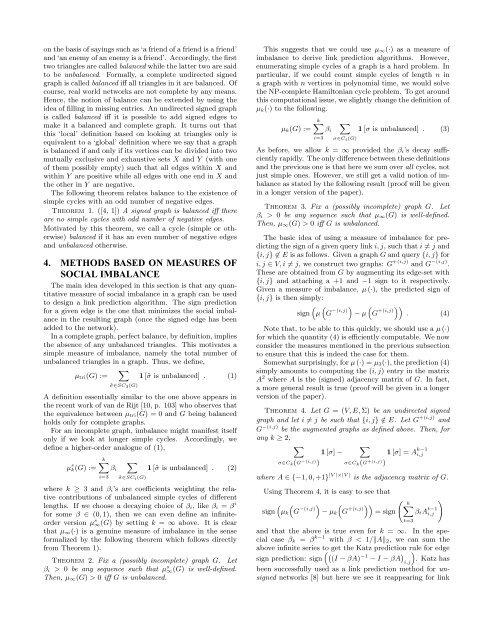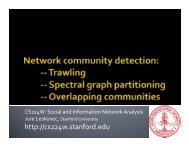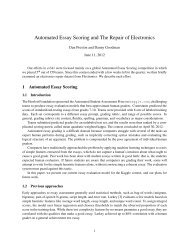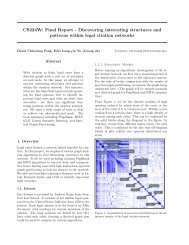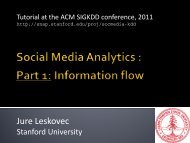Exploiting Longer Cycles for Link Prediction in Signed Networks
Exploiting Longer Cycles for Link Prediction in Signed Networks
Exploiting Longer Cycles for Link Prediction in Signed Networks
Create successful ePaper yourself
Turn your PDF publications into a flip-book with our unique Google optimized e-Paper software.
on the basis of say<strong>in</strong>gs such as ‘a friend of a friend is a friend’<br />
and ‘an enemy of an enemy is a friend’. Accord<strong>in</strong>gly, the first<br />
two triangles are called balanced while the latter two are said<br />
to be unbalanced. Formally, a complete undirected signed<br />
graph is called balanced iff all triangles <strong>in</strong> it are balanced. Of<br />
course, real world networks are not complete by any means.<br />
Hence, the notion of balance can be extended by us<strong>in</strong>g the<br />
idea of fill<strong>in</strong>g <strong>in</strong> miss<strong>in</strong>g entries. An undirected signed graph<br />
is called balanced iff it is possible to add signed edges to<br />
make it a balanced and complete graph. It turns out that<br />
this ‘local’ def<strong>in</strong>ition based on look<strong>in</strong>g at triangles only is<br />
equivalent to a ‘global’ def<strong>in</strong>ition where we say that a graph<br />
is balanced if and only if its vertices can be divided <strong>in</strong>to two<br />
mutually exclusive and exhaustive sets X and Y (with one<br />
of them possibly empty) such that all edges with<strong>in</strong> X and<br />
with<strong>in</strong> Y are positive while all edges with one end <strong>in</strong> X and<br />
the other <strong>in</strong> Y are negative.<br />
The follow<strong>in</strong>g theorem relates balance to the existence of<br />
simple cycles with an odd number of negative edges.<br />
Theorem 1. ([4, 1]) A signed graph is balanced iff there<br />
are no simple cycles with odd number of negative edges.<br />
Motivated by this theorem, we call a cycle (simple or otherwise)<br />
balanced if it has an even number of negative edges<br />
and unbalanced otherwise.<br />
4. METHODS BASED ON MEASURES OF<br />
SOCIAL IMBALANCE<br />
The ma<strong>in</strong> idea developed <strong>in</strong> this section is that any quantitative<br />
measure of social imbalance <strong>in</strong> a graph can be used<br />
to design a l<strong>in</strong>k prediction algorithm. The sign prediction<br />
<strong>for</strong> a given edge is the one that m<strong>in</strong>imizes the social imbalance<br />
<strong>in</strong> the result<strong>in</strong>g graph (once the signed edge has been<br />
added to the network).<br />
In a complete graph, perfect balance, by def<strong>in</strong>ition, implies<br />
the absence of any unbalanced triangles. This motivates a<br />
simple measure of imbalance, namely the total number of<br />
unbalanced triangles <strong>in</strong> a graph. Thus, we def<strong>in</strong>e,<br />
µtri(G) := X<br />
1[˜σ is unbalanced] . (1)<br />
˜σ∈SC3(G)<br />
A def<strong>in</strong>ition essentially similar to the one above appears <strong>in</strong><br />
the recent work of van de Rijt [10, p. 103] who observes that<br />
the equivalence between µtri(G) = 0 and G be<strong>in</strong>g balanced<br />
holds only <strong>for</strong> complete graphs.<br />
For an <strong>in</strong>complete graph, imbalance might manifest itself<br />
only if we look at longer simple cycles. Accord<strong>in</strong>gly, we<br />
def<strong>in</strong>e a higher-order analogue of (1),<br />
µ s k(G) :=<br />
kX<br />
i=3<br />
βi<br />
X<br />
˜σ∈SC i(G)<br />
1[˜σ is unbalanced] . (2)<br />
where k ≥ 3 and βi’s are coefficients weight<strong>in</strong>g the relative<br />
contributions of unbalanced simple cycles of different<br />
lengths. If we choose a decay<strong>in</strong>g choice of βi, like βi = β i<br />
<strong>for</strong> some β ∈ (0,1), then we can even def<strong>in</strong>e an <strong>in</strong>f<strong>in</strong>iteorder<br />
version µ s ∞(G) by sett<strong>in</strong>g k = ∞ above. It is clear<br />
that µ∞(·) is a genu<strong>in</strong>e measure of imbalance <strong>in</strong> the sense<br />
<strong>for</strong>malized by the follow<strong>in</strong>g theorem which follows directly<br />
from Theorem 1).<br />
Theorem 2. Fix a (possibly <strong>in</strong>complete) graph G. Let<br />
βi > 0 be any sequence such that µ s ∞(G) is well-def<strong>in</strong>ed.<br />
Then, µ∞(G) > 0 iff G is unbalanced.<br />
This suggests that we could use µ∞(·) as a measure of<br />
imbalance to derive l<strong>in</strong>k prediction algorithms. However,<br />
enumerat<strong>in</strong>g simple cycles of a graph is a hard problem. In<br />
particular, if we could count simple cycles of length n <strong>in</strong><br />
a graph with n vertices <strong>in</strong> polynomial time, we would solve<br />
the NP-complete Hamiltonian cycle problem. To get around<br />
this computational issue, we slightly change the def<strong>in</strong>ition of<br />
µk(·) to the follow<strong>in</strong>g.<br />
µk(G) :=<br />
kX<br />
i=3<br />
βi<br />
X<br />
σ∈C i(G)<br />
1[σ is unbalanced] . (3)<br />
As be<strong>for</strong>e, we allow k = ∞ provided the βi’s decay sufficiently<br />
rapidly. The only difference between these def<strong>in</strong>itions<br />
and the previous one is that here we sum over all cycles, not<br />
just simple ones. However, we still get a valid notion of imbalance<br />
as stated by the follow<strong>in</strong>g result (proof will be given<br />
<strong>in</strong> a longer version of the paper).<br />
Theorem 3. Fix a (possibly <strong>in</strong>complete) graph G. Let<br />
βi > 0 be any sequence such that µ∞(G) is well-def<strong>in</strong>ed.<br />
Then, µ∞(G) > 0 iff G is unbalanced.<br />
The basic idea of us<strong>in</strong>g a measure of imbalance <strong>for</strong> predict<strong>in</strong>g<br />
the sign of a given query l<strong>in</strong>k i, j, such that i = j and<br />
{i, j} ∈ E is as follows. Given a graph G and query {i, j} <strong>for</strong><br />
i, j ∈ V, i = j, we construct two graphs: G +(i,j) and G −(i,j) .<br />
These are obta<strong>in</strong>ed from G by augment<strong>in</strong>g its edge-set with<br />
{i, j} and attach<strong>in</strong>g a +1 and −1 sign to it respectively.<br />
Given a measure of imbalance, µ(·), the predicted sign of<br />
{i, j} is then simply:<br />
sign<br />
“<br />
µ<br />
“<br />
G −(i,j)”<br />
− µ<br />
“<br />
G +(i,j)””<br />
. (4)<br />
Note that, to be able to this quickly, we should use a µ(·)<br />
<strong>for</strong> which the quantity (4) is efficiently computable. We now<br />
consider the measures mentioned <strong>in</strong> the previous subsection<br />
to ensure that this is <strong>in</strong>deed the case <strong>for</strong> them.<br />
Somewhat surpris<strong>in</strong>gly, <strong>for</strong> µ(·) = µ3(·), the prediction (4)<br />
simply amounts to comput<strong>in</strong>g the (i, j) entry <strong>in</strong> the matrix<br />
A 2 where A is the (signed) adjacency matrix of G. In fact,<br />
a more general result is true (proof will be given <strong>in</strong> a longer<br />
version of the paper).<br />
Theorem 4. Let G = (V, E,Σ) be an undirected signed<br />
graph and let i = j be such that {i, j} /∈ E. Let G +(i,j) and<br />
G −(i,j) be the augmented graphs as def<strong>in</strong>ed above. Then, <strong>for</strong><br />
any k ≥ 2,<br />
X<br />
σ∈C k(G −(i,j) )<br />
1[σ] −<br />
X<br />
σ∈C k(G +(i,j) )<br />
1[σ] = A k−1<br />
i,j<br />
where A ∈ {−1, 0,+1} |V |×|V | is the adjacency matrix of G.<br />
Us<strong>in</strong>g Theorem 4, it is easy to see that<br />
“ “<br />
sign µk G −(i,j)”<br />
“<br />
− µk G +(i,j)””<br />
= sign<br />
kX<br />
t=3<br />
βtA t−1<br />
i,j<br />
and that the above is true even <strong>for</strong> k = ∞. In the special<br />
case βk = β k−1 with β < 1/A2, we can sum the<br />
above <strong>in</strong>f<strong>in</strong>ite series to “ get the Katz prediction rule <strong>for</strong> edge<br />
`(I ´ ”<br />
−1<br />
sign prediction: sign − βA) − I − βA . Katz has<br />
i,j<br />
been successfully used as a l<strong>in</strong>k prediction method <strong>for</strong> unsigned<br />
networks [8] but here we see it reappear<strong>in</strong>g <strong>for</strong> l<strong>in</strong>k<br />
!


